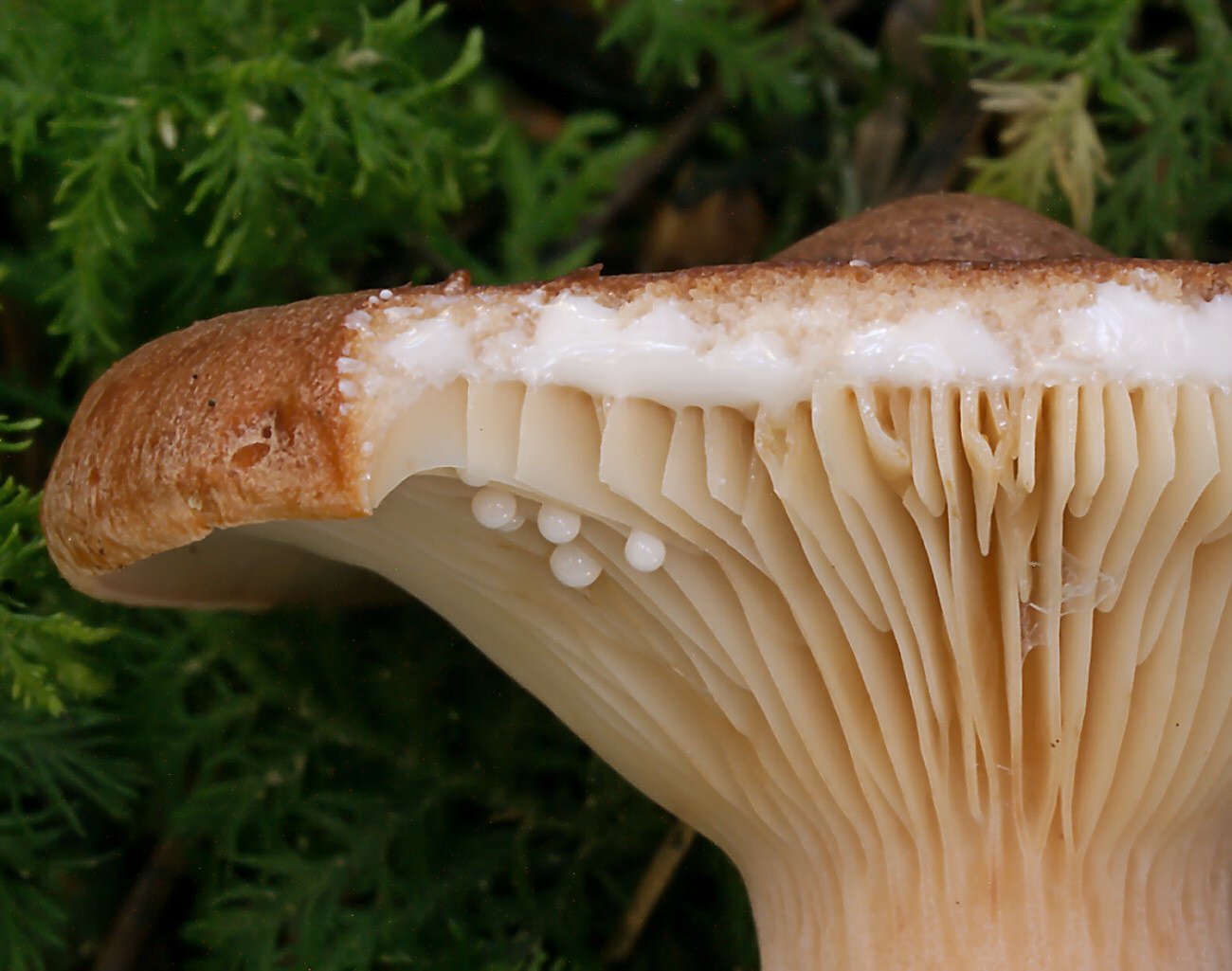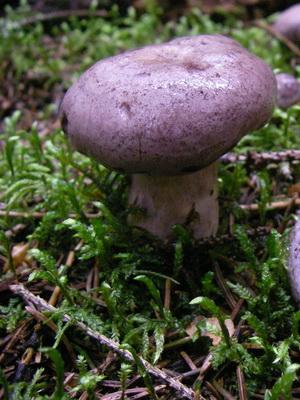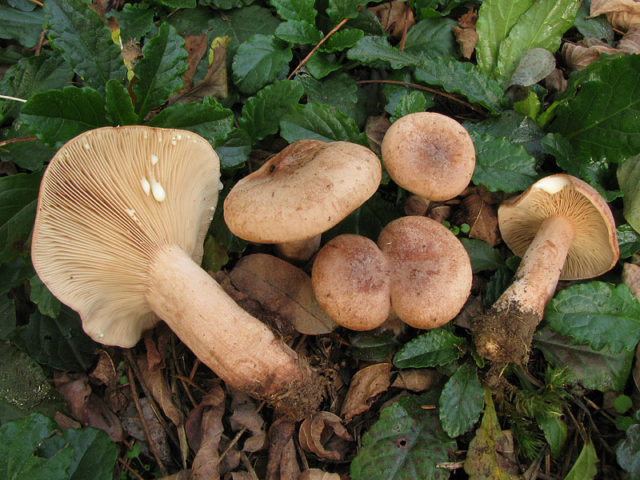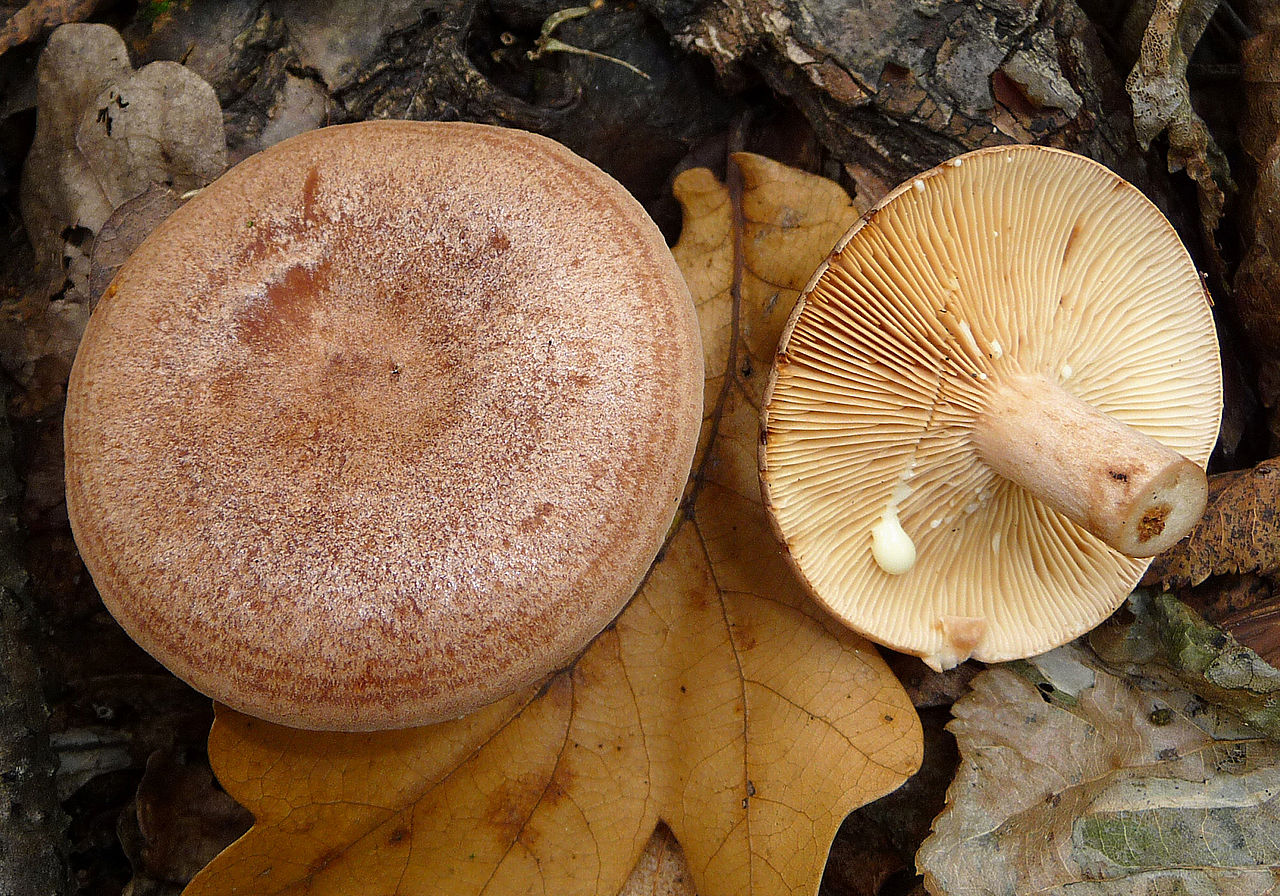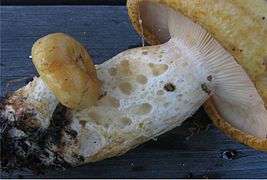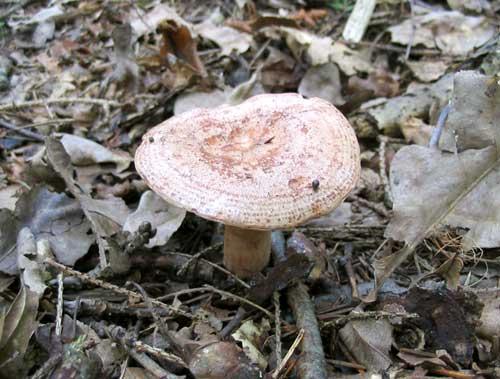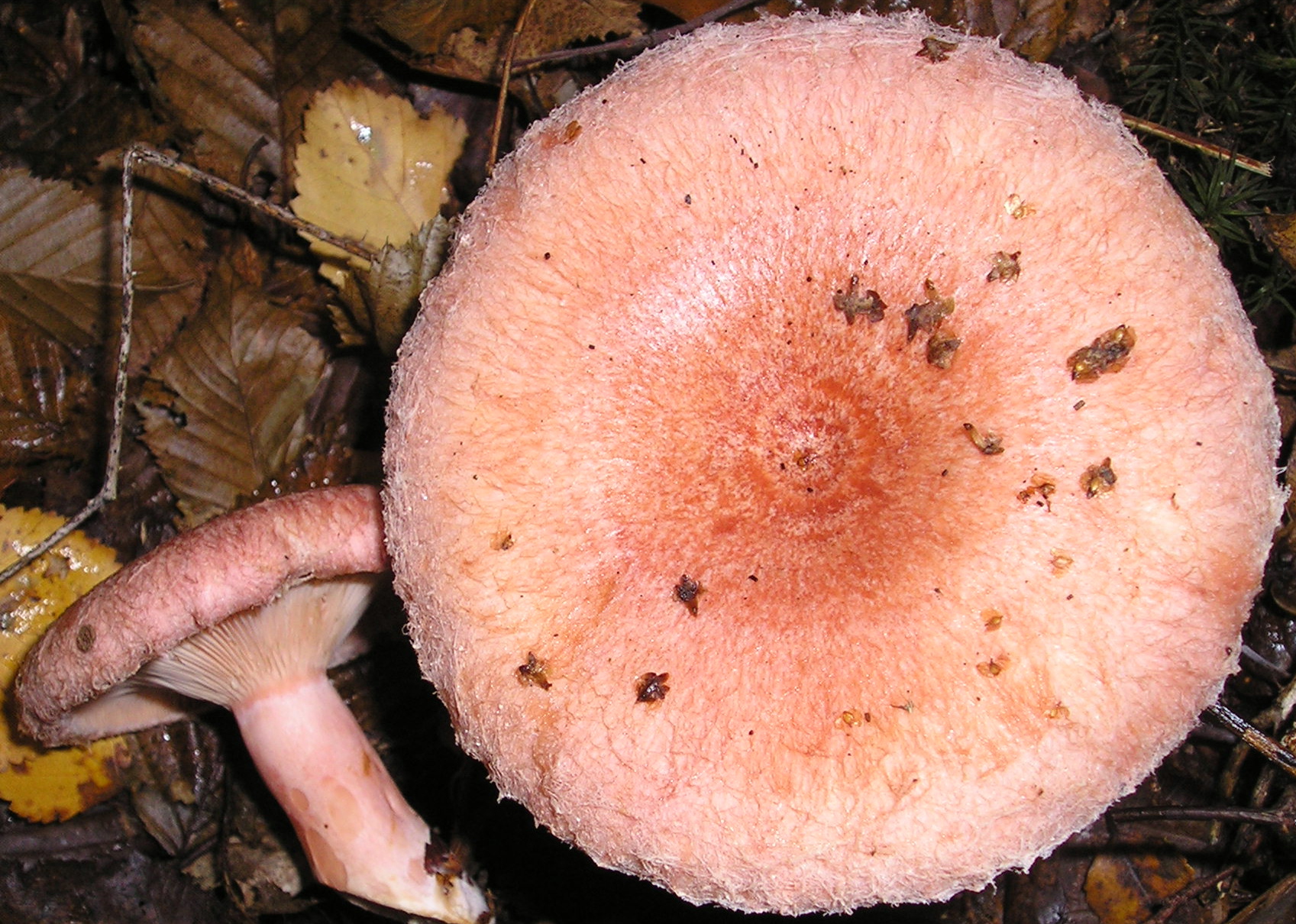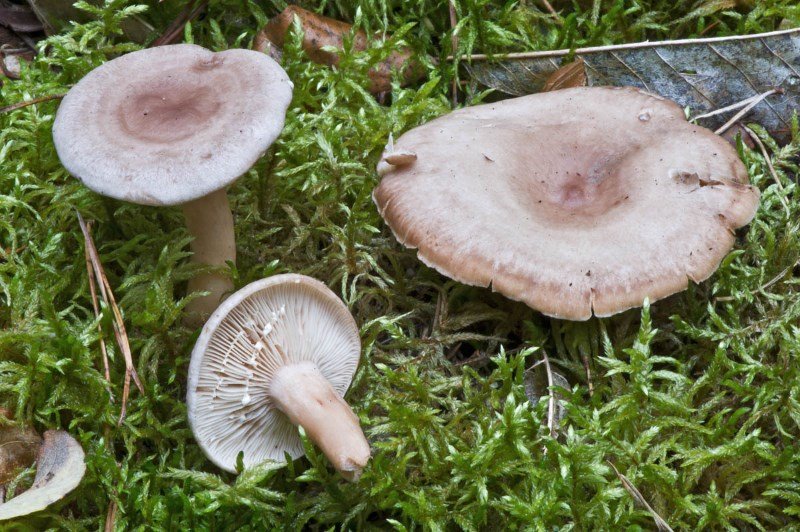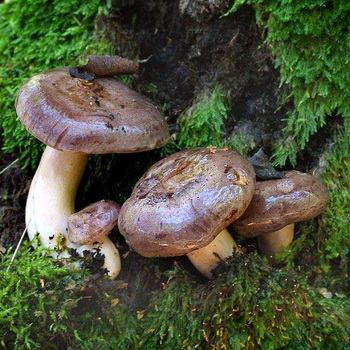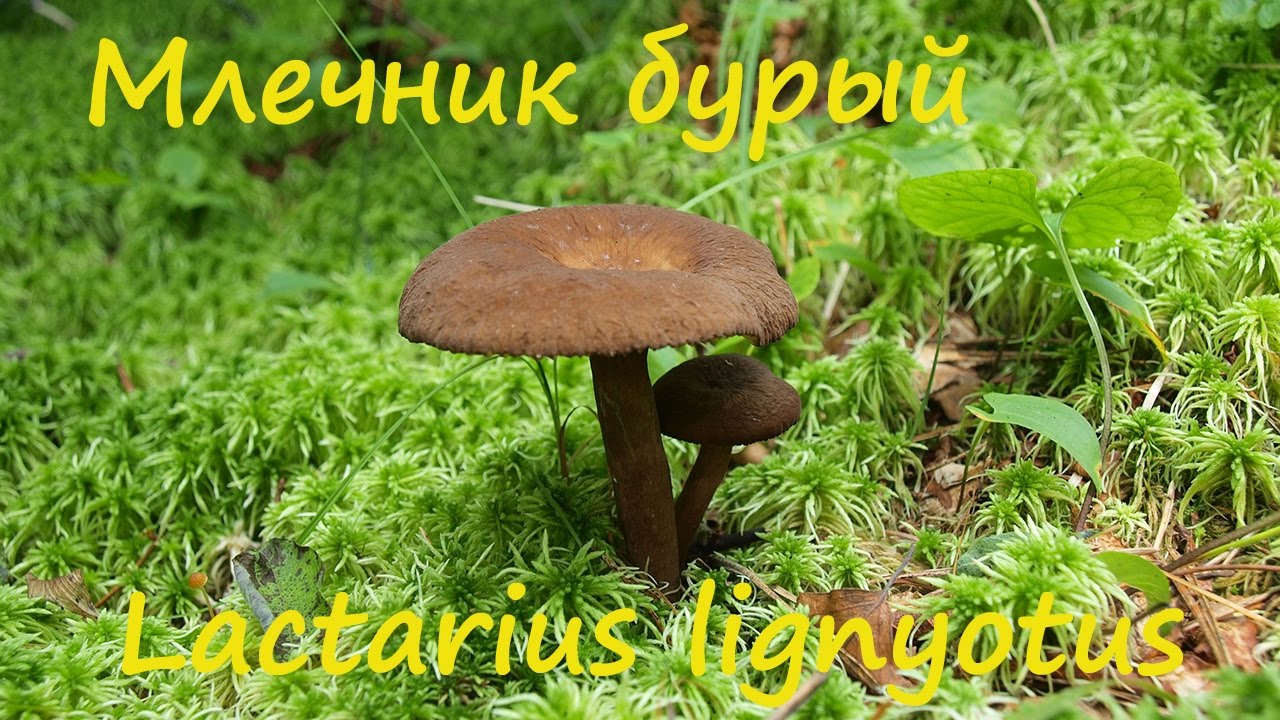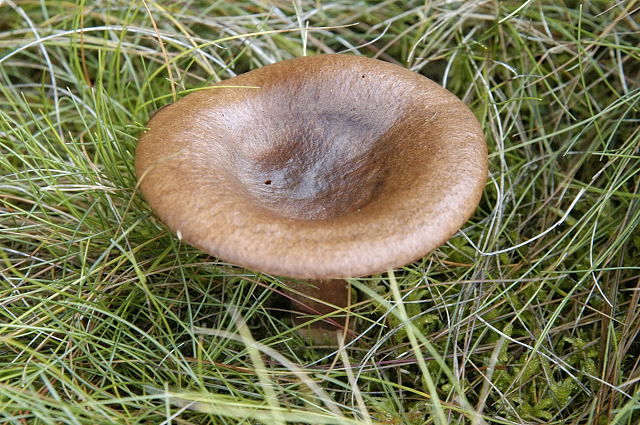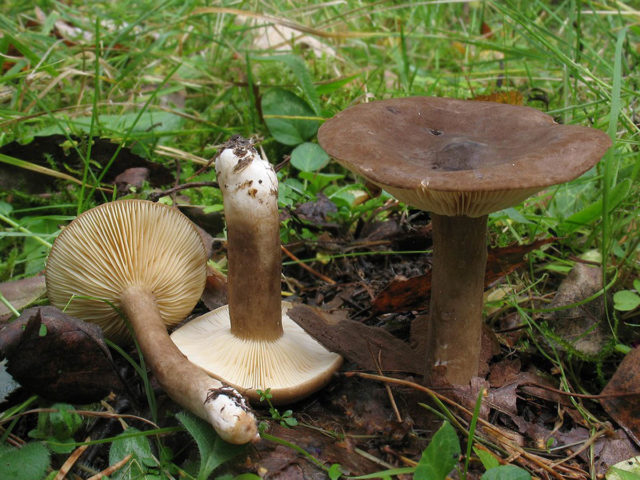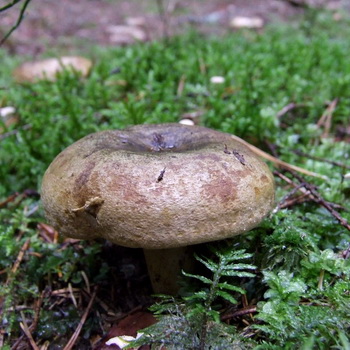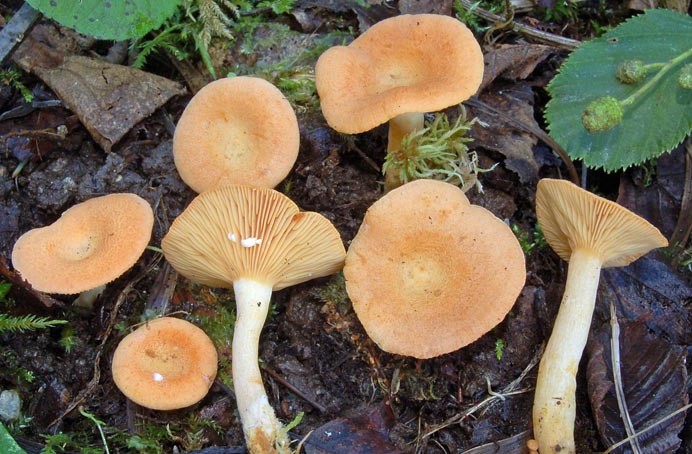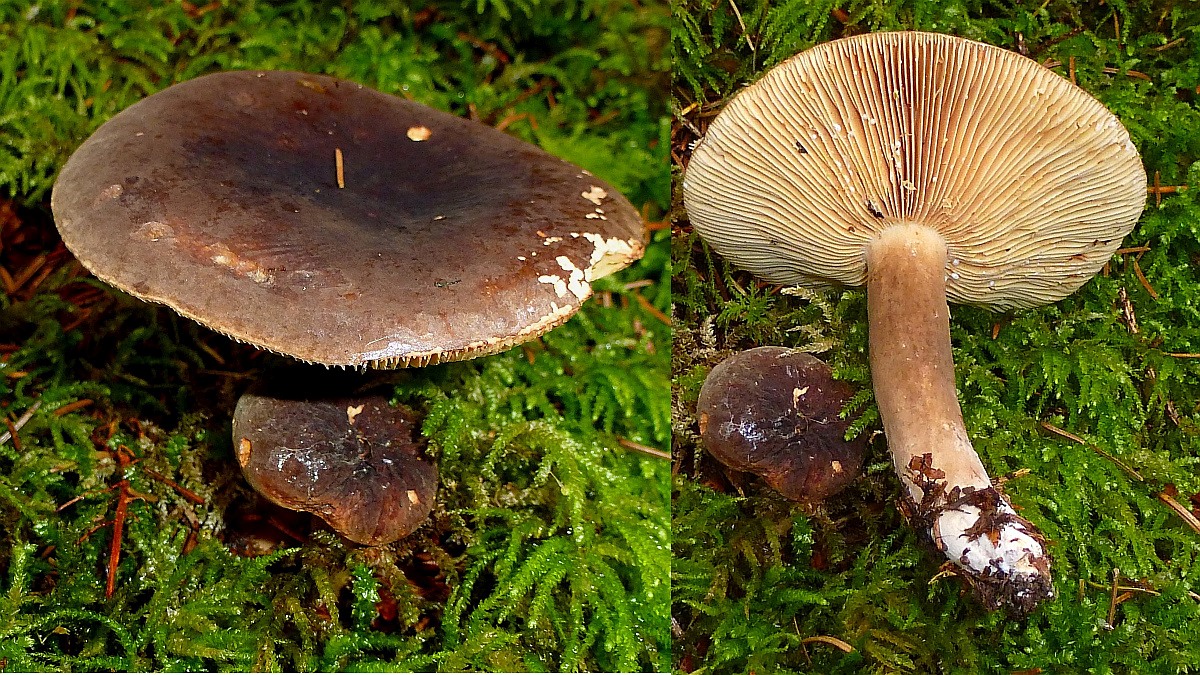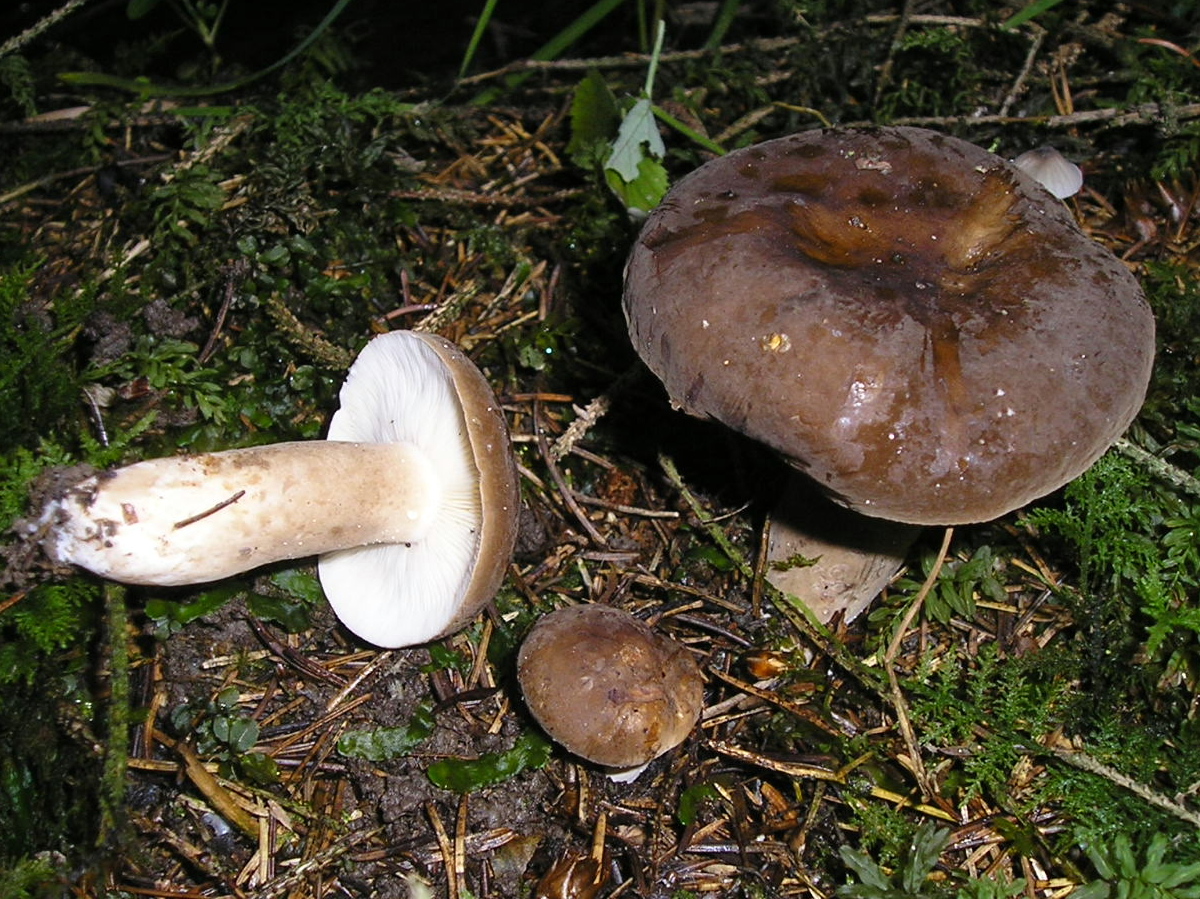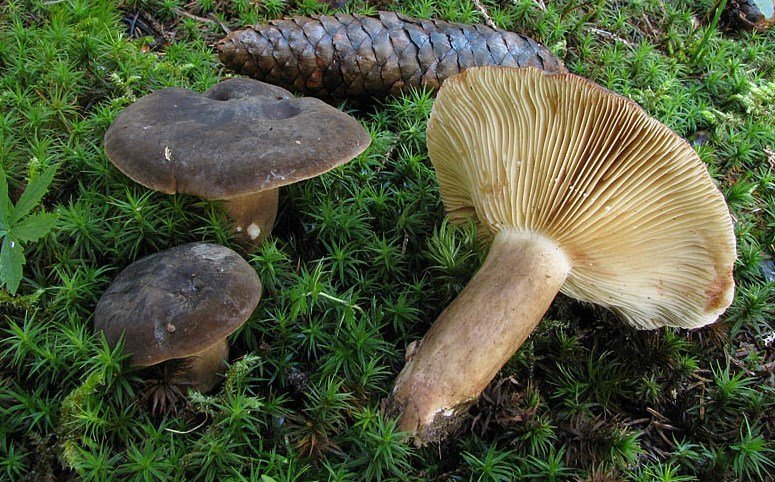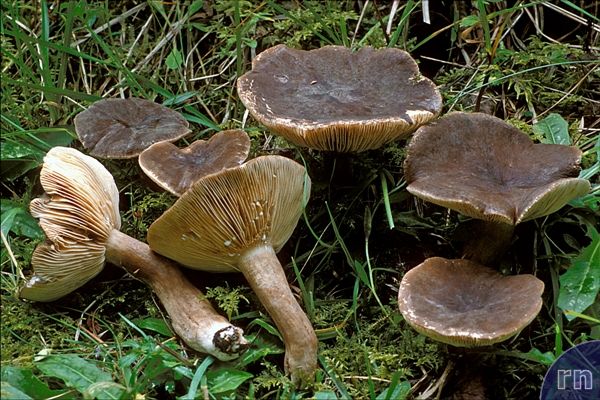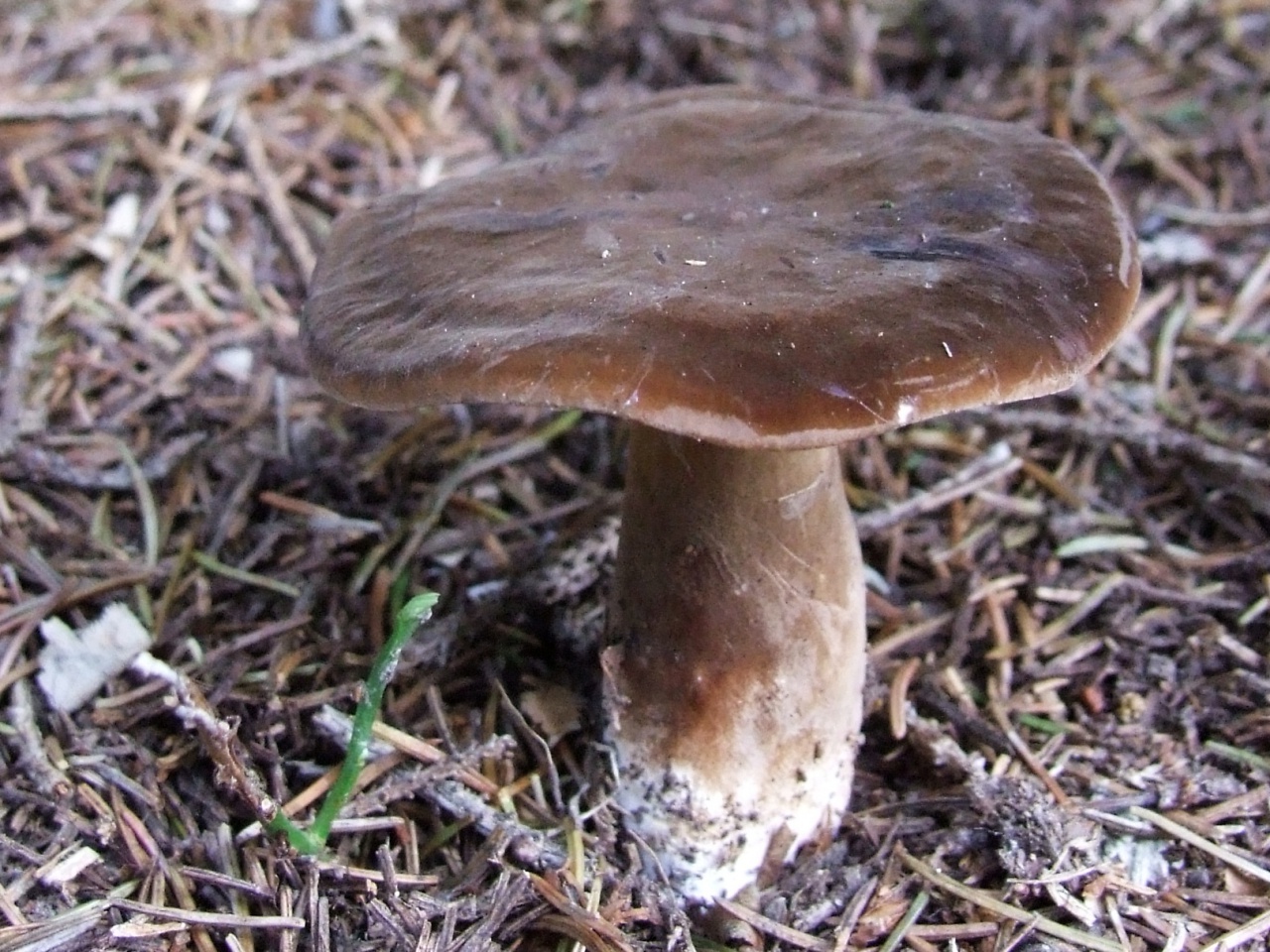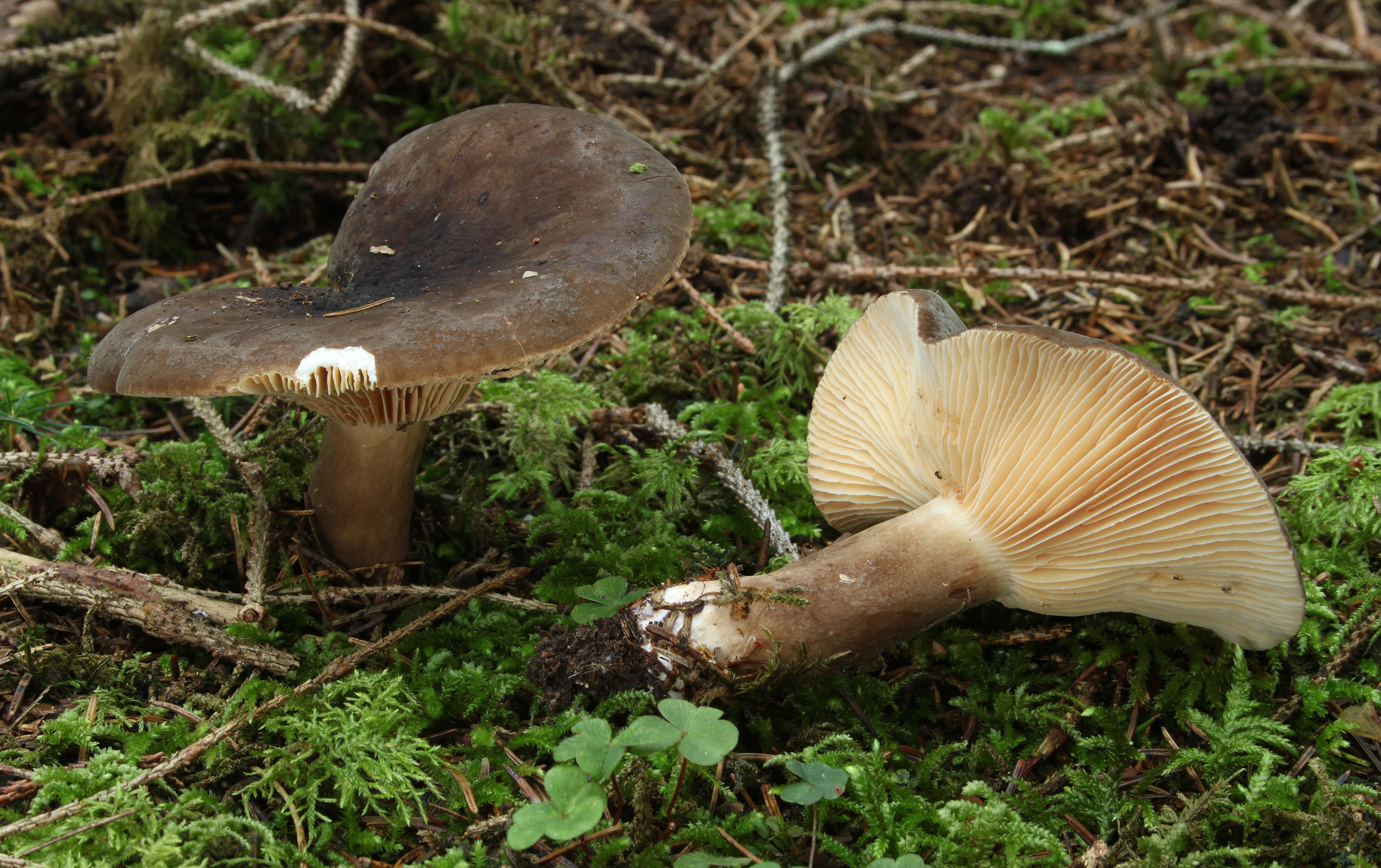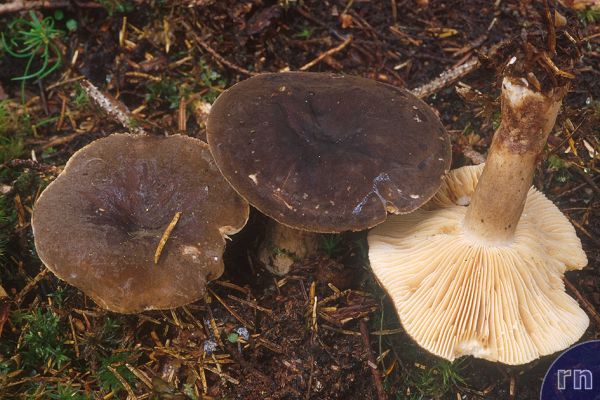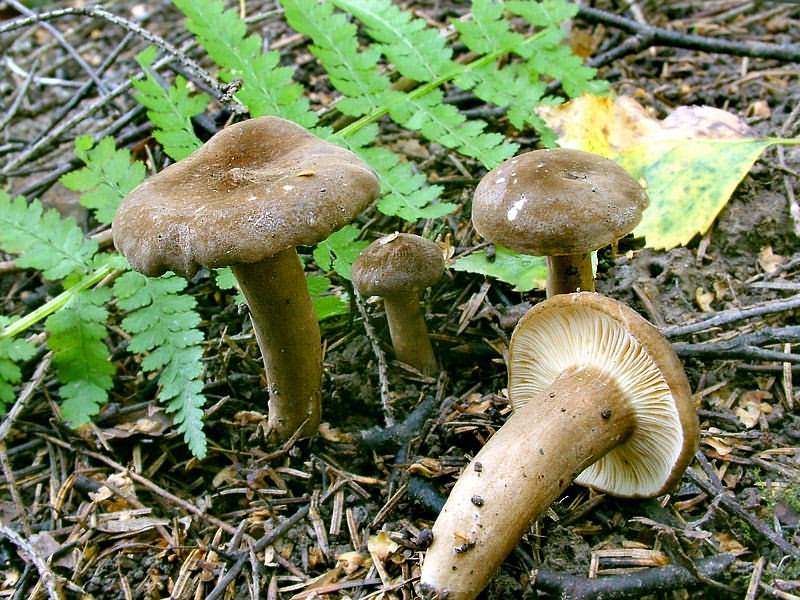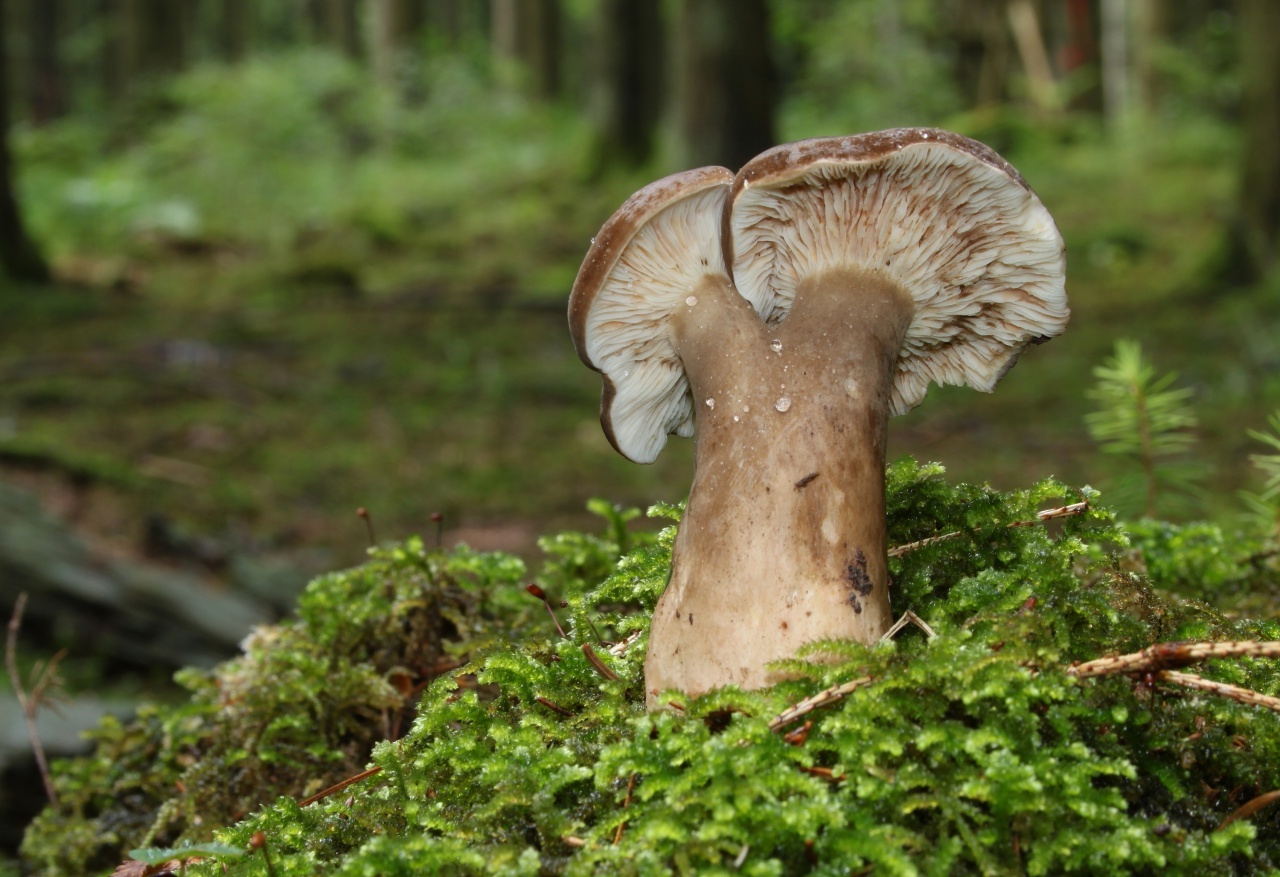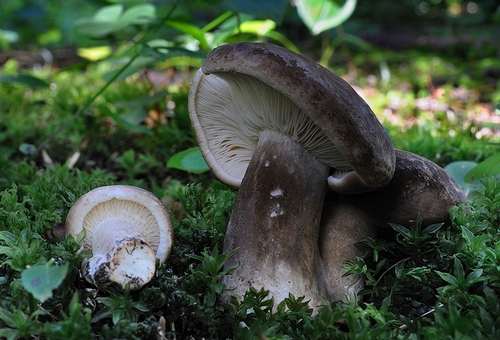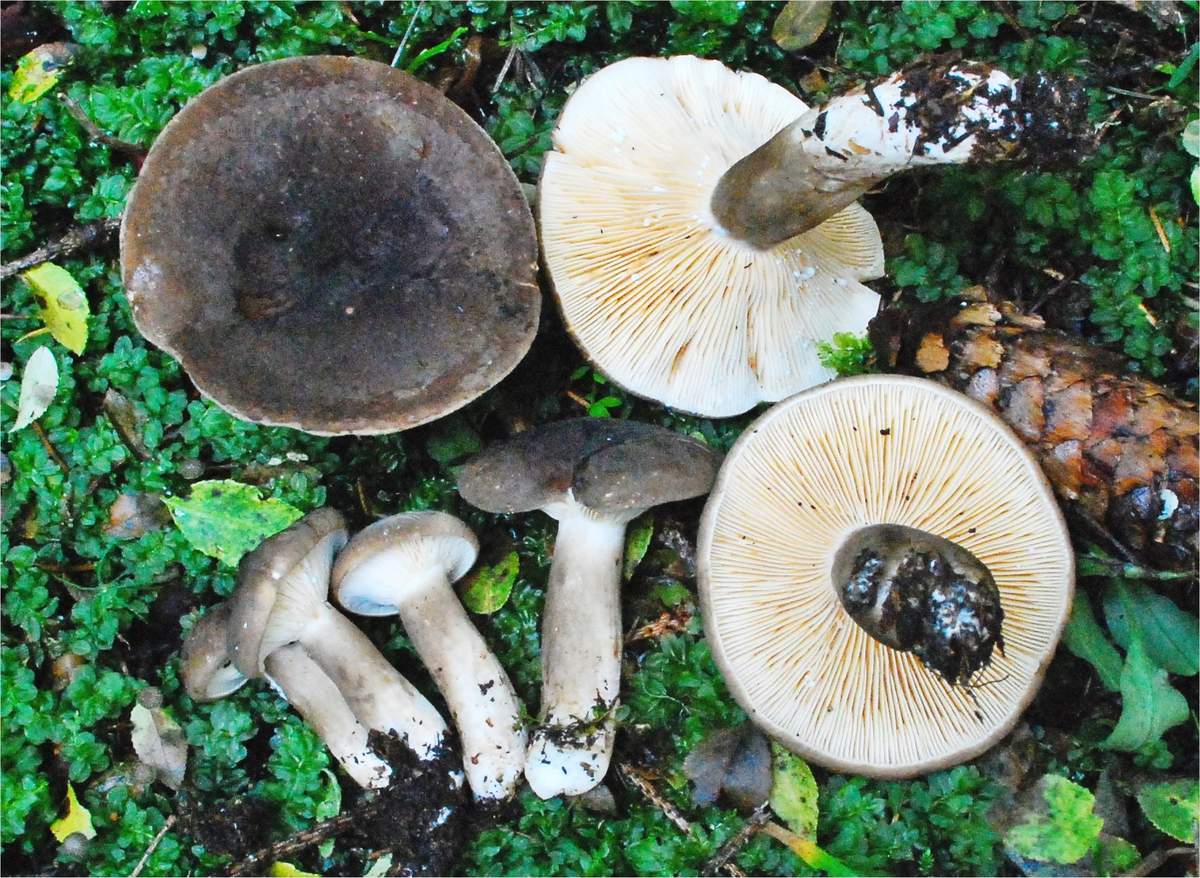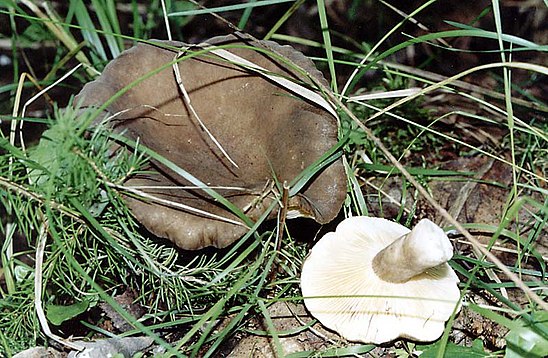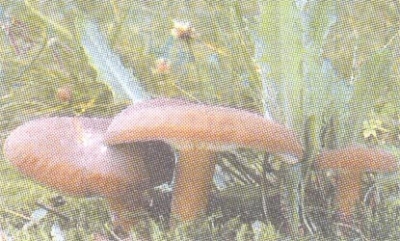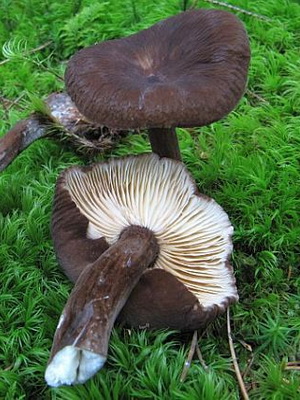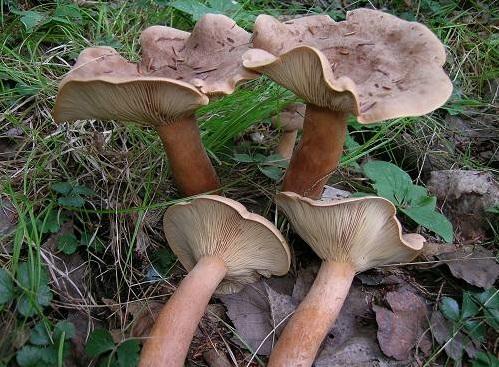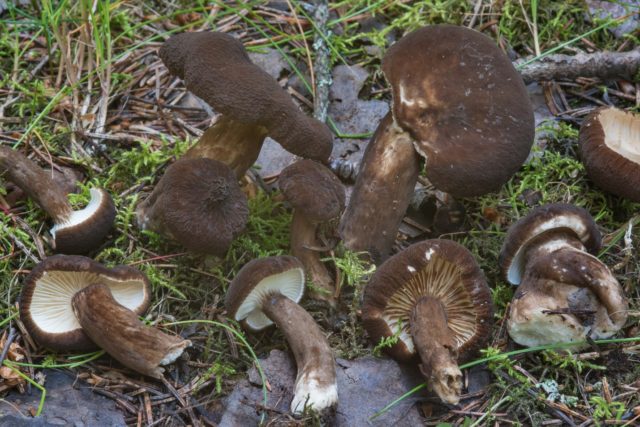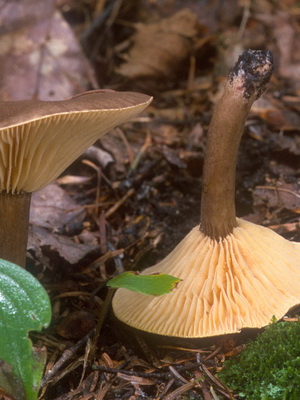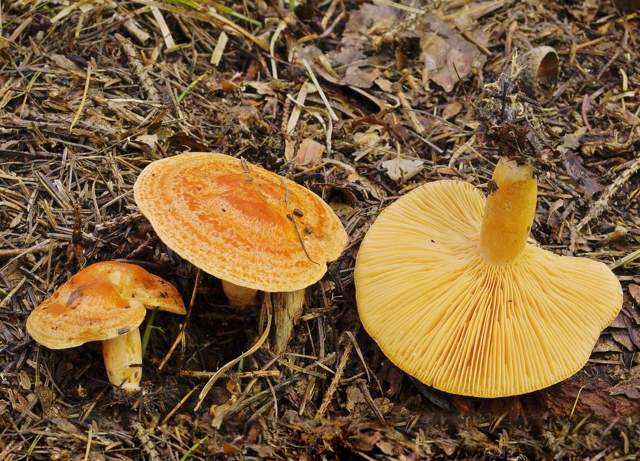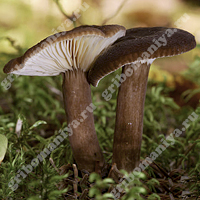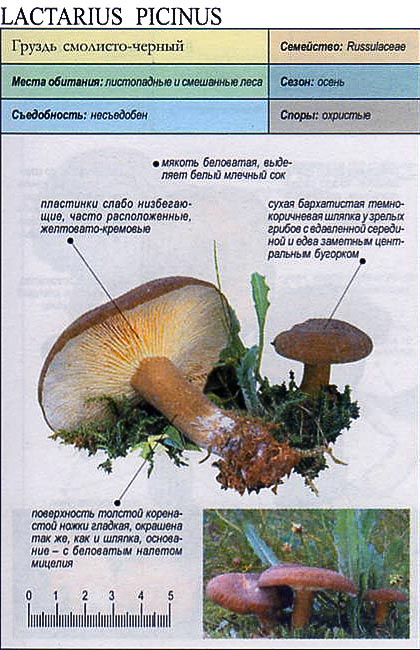Description of the resinous black milkman
The diameter of the cap varies from 4 to 10 centimeters. In youth, the shape of the cap of this lactarius is convex, later it becomes prostrate or slightly depressed. The skin is velvety, brown-brown in color; at the edge, the shade may be lighter.
The pulp is very dense, but brittle, white in color, turns yellow with age. On contact with air, the pulp becomes firm, red.
The milky juice is thick, white, and a red tint appears in the air. The flesh has a strong peppery taste, but at first it seems sweetish. And the sharpness comes later. The mushroom has a pleasant fruity smell.

The plates are not densely planted, they are very wide, sometimes bifurcated, slightly descending along the leg. The color of the plates varies from orange-yellow to off-white. Spore powder of ocher color. Spores are oval in shape, with an ornamented surface.
The leg height is 3-6 centimeters, and the thickness is 1-1.5 centimeters. Its shape is cylindrical, narrowing is noticeable towards the base. There may be fluff at the bottom of the leg. In youth, the legs are solid, but over time they become hollow in places. The leg is colored unevenly: in the upper part it is whitish, and at the bottom it becomes brown-ocher.
Places of growth and time of fruiting of resinous black lactarias
Resinous black lactaries bear fruit individually or in small groups. They grow in mixed or coniferous forests. You can find them under the pine trees. The fruiting season lasts from August to September.

Other mushrooms of this genus
The Mayor's Millennium has a hat with a diameter of 2.5 to 12 centimeters. The edges of the caps in young specimens are bent, but as they mature, they straighten. The surface of the cap is dry and smooth. The length of the stem is 1.5-4 centimeters, and its thickness is 0.6-1.5 cm. The color of the cap varies from cream to clay-cream. The leg is cylindrical. Its surface is smooth, without the slightest dents.
The legs of young fruiting bodies are full, and with age they become hollow. The color of the leg is creamy yellow, pink-cream, or creamy red. The pulp is whitish in color, medium density. The pulp has a burning aftertaste. The pulp has a fruity smell.

Mayor's milkmen grow mainly in deciduous forests. They settle in small groups. These mushrooms are widespread in Europe, Asia and Morocco. They bear fruit actively from September to October. The Mayr's Miller is an edible species that can be eaten in any form.
The hepatic miller has a cap with a diameter of 3-6 centimeters. The color of the cap is liver-brown, which is where the name of the mushroom comes from.
The surface of the cap is smooth, the middle is depressed or funnel-shaped. Plates are frequent, adherent to the stem, brown, pinkish or ocher in color. The leg height is 3-6 centimeters, and the thickness is 0.6-1 centimeters. The shape of the leg is cylindrical. The color of the leg and cap is the same, but the leg is slightly lighter.
These fungi form mycorrhiza with pine trees. They prefer sandy and acidic soils. Liver millers are considered inedible mushrooms, as they have a pungent taste. The pulp is brittle, thin, creamy or light brown in color. Milky juice is released from the pulp, which turns yellow in air.

Other milkmen
The wet miller has a cap with a diameter of 4-8 centimeters. In youth, the shape of the caps is convex, over time it changes to prostrate, then it becomes depressed, with a wide flat tubercle in the central part. The edge of the cap is bent, with a small pile. The color of the cap is steel-gray with a purple tint. The hat is smooth, sticky, and damp. The flesh of this mushroom is spongy, tender, its color is white, slightly yellowish, it quickly turns purple on the cut.
The pulp secretes abundant milky juice. The pulp has a pungent taste, and there is no particular smell. The leg height is 4-7 centimeters, and the thickness is 1-2 centimeters. The shape of the leg is cylindrical; towards the base it becomes narrower. The leg is strong in structure, its surface is sticky.
Wet milkers bear fruit from August to September. They are rare enough.They grow in small groups or individually. These are inedible or slightly poisonous mushrooms. They can be found in mixed and deciduous forests, in humid places, near birches.
The sharpest miller is characterized by a cap, the diameter of which is 2-10 centimeters, concave with a slightly wavy edge. The hat is naked, smooth, it becomes wet in damp weather.
The color combines different shades of ocher, while the center of the cap is darker. The length of the leg reaches 10 centimeters, with a thickness of 1.5 centimeters. The leg is hollow, cylindrical, with a smooth surface, slightly lighter than the cap. The pulp is dense, white, with a sharp taste, without any special smell. Milky juice white... The sharpest milkmen grow in the deciduous forests of Europe. They can be found under the oak trees. These are inedible mushrooms.
The color combines different shades of ocher, while the center of the cap is darker. The length of the leg reaches 10 centimeters, with a thickness of 1.5 centimeters. The leg is hollow, cylindrical, with a smooth surface, slightly lighter than the cap. The pulp is dense, white, with a sharp taste, without any special smell. Milky juice is white. The sharpest milkmen grow in the deciduous forests of Europe. They can be found under the oak trees. These are inedible mushrooms.
The miller is pale, or dull, or pale yellow has a cap up to 12 centimeters in diameter. The shape is convex in young milkers, and in mature ones it becomes funnel-shaped-depressed. The surface of the cap is smooth, slimy. The color of the cap is light ocher. The leg length ranges from 7 to 9 centimeters and the thickness is 1.5 centimeters. The color of the leg is the same as the cap. The leg is cylindrical, empty inside. The pulp is creamy or white, rather thick with a pleasant aroma and pungent taste.
Pale milkmen bear fruit from July to August. These fungi form mycorrhiza with oaks and birches. They are rare, mainly in deciduous, mixed forests and oak forests. Fruiting bodies grow in small groups. Pale millers are conditionally edible mushrooms. Most often they are salted with other delicious mushrooms.
Millechnik: photo and description of the genus of mushrooms. What do milkmen look like?
Millers are mushrooms with thin or thick fleshy, dense, but fragile fruit bodies, mostly of medium or large size. Their cap and stem are homogeneous (homogeneous) and do not separate from each other without breaking, as, for example, in a champignon. There are stocky mushrooms with a thick stem, approximately equal in length to the diameter of the cap (Lactarius deliciosus, Lactarius pubescens, Lactarius turpis), and there are also species in which a small cap is placed on a long, relatively thin stem (Lactarius camphoratus, Lactarius lignyotus). Both the private and the general veil are absent in fungi of this genus.
The cap of the lactarius can be funnel-shaped, depressed, convex-outstretched, or convex. In young mushrooms, it is straight or convex with the edge tucked down. White or brightly colored (yellow, orange, gray, pink, brown, blue, purple, olive-black), with a wavy, straight or ribbed edge. With age, some mushrooms change the color of their fruit chalk.
The surface of the lactic cap is dry or slimy, smooth, scaly, fleecy or velvety, monochromatic or with concentric circular zones and grooves - lacunae. The size of the cap is from 8 to 40 cm (Lactarius vellereus). In a stunted lactarius (lat. Lactarius tabidus) and a dark lactarius (lat. Lactarius obscuratus), the cap is capable of swelling, absorbing water.
The miller is stunted.
The flower is pink.
The hymenophore of these fungi is lamellar. The lamellar plates descend to the pedicle to varying degrees, attaching to it strongly in some species, insignificantly in others. Plates with anastomoses or notched, are both white and colored in bright colors: pink, bluish, pale ocher, cream. Can change color when touched. For example, the plates of the lilac lilac (lat.Lactarius violascens) are initially white or creamy yellow, when squeezed they turn purple.
Spruce ginger.
A characteristic feature of the lactarius and russula in general is the net pattern on their spores. The cells themselves, intended for reproduction, are more often spherical, broadly oval or oval in shape. Spore powder is white, ocher or yellowish cream.
Spores of the aromatic lactarius under the microscope.
The leg of the lactarius is attached to the cap in the center; its shape is regular cylindrical, flattened or narrowed towards the base. It is white or the same color as the cap, sometimes hollow inside, often with chambers or full. The surface is smooth, dry, less often slimy and sticky.
Some species have depressions (lacunae), colored somewhat darker than the rest of the skin of the leg. The height of the leg of the lactarius is 5-8 cm, its diameter is 1.5-2 cm.
Miller is neutral.
The pulp of the lactarius is fragile, white or with a brownish, creamy or fawn tint. It can change color when exposed to air. It contains conductive thick-walled hyphae with milky juice.
The color of the milky sap and its change in air are an important systematic sign by which the species of the genus are distinguished. Most often it is white, but in some species in the air it slowly turns green, gray, yellow, becomes purple, red, etc. In the North American blue milkman (Latin Lactarius indigo), the juice, like the entire fruit body, is blue.
Bitter.
The blue milkman.
Significance in human life [| ]
According to M.V. Vishnevsky, all species of the genus are edible.
In Europe, the overwhelming number of species of the genus Lactarius
considered inedible, or even poisonous. In Russia, many species are considered edible, usually in salted or pickled form.
Some lactosers are used in medicine. From this mushroom (Lactarius deliciosus
) and close to it red mushroom (Lactarius sanguifluus ) with red milky juice, the antibiotic lactarioviolin was isolated, which suppresses the development of many bacteria, including the causative agent of tuberculosis. Pepper milk (Lactarius piperatus ) is used in the treatment of kidney and gallstone diseases, blennorrhea, acute purulent conjunctivitis. Bitter (Lactarius rufus ) contains an antibiotic substance that adversely affects a number of bacteria, as well as inhibits the growth of cultures of Staphylococcus aureus [source not specified 1347 days ].
Pickled shiitake mushrooms, usually grown in China, are often sold under the name "pickled milk mushrooms" and are also edible.
In philately
As of 2020, there have been at least 114 different postage stamps issued around the world with images of the dairymen.
Lactarius piperatus on a Moldavian postage stamp (# 694) Lactarius piperatus on a Romanian postage stamp (# 4290)
- Lactarius blennius - Guinea (# 2523)
- Lactarius camphoratus - Guyana (# 3683), Mauritania (# 1059), Niger (# 1734)
- Lactarius chrysorrheus - Guinea-Bissau (# 3863)
- Lactarius claricolor - Madagascar (# 1632)
- Lactarius deceptivus - Mali (# 1484)
- Lactarius deliciosus - Algeria (# 1013), Angola (# 1421), Bulgaria (# 1267) (# 1275), Botswana (# 318), Guinea (# 762) (# 4255) (# 4681) (# 4741), Guinea -Bissau (# 849), Honduras (# 1845), Spain (# 3143), Cyprus (# 924), Lesotho (# 1317), Liberia (# 4025), Mali (# 1480), Mozambique (# 1058), Nicaragua (# 3003), Poland (# 1096), Romania (# 1724) (# 6263), Sao Tome and Principe (# 1631), Saint Vincent and the Grenadines (# 5204), Somalia (# 503), USSR (# 2987), Sierra Leone (# 1078) (# 3723) (# 5215), Togo (# 2355) (# 2818), Turkey (# 3034), Uganda (# 2930), Croatia (# 255), CAR (# 2876)
- Lactarius deterrimus - Afghanistan (# 1845), Norway (# 991), Finland (# 830)
- Lactarius dryadophilus - Greenland (# 465) (# 468)
- Lactarius fulvissimus - Guinea (# 2548) (# 2556)
- Lactarius gymnocarpus - Cote d'Ivoire (# 1194)
- Lactarius helvus - Guinea-Bissau (# 4302), Liberia (# 5240)
- Lactarius hepaticus - Guinea (# 5217)
- Lactarius hygrophoroides - Bhutan (# 2077), Grenadines (Grenada) (# 1447), DPRK (# 3001)
- Lactarius indigo - Guyana (# 6932), Guinea (# 1613), Liberia (# 4026), Mali (# 1485), El Salvador (# 2258), Sierra Leone (# 2573) (# 2579)
- Lactarius lignyotus - Mali (# 1487), Monaco (# 1864), Switzerland (# 2339)
- Lactarius luculentus - Mali (# 1481)
- Lactarius pandani - Madagascar (# 1314) (# 1541)
- Lactarius peckii - Mali (# 1486), Saint Vincent and the Grenadines (# 5210)
- Lactarius phlebonemus - DRC (# 602) (# 1072)
- Lactarius piperatus - Moldova (# 694), Romania (# 4290)
- Lactarius porninsis - Guinea (# 2529)
- Lactarius pseudomucidus - Mali (# 1482)
- Lactarius putidus - Grenadines (Grenada) (# 774)
- Lactarius resimus - Mongolia (# 1138)
- Lactarius rufus - Nevis (# 1146), Saint Vincent and the Grenadines (# 5211)
- Lactarius romagnesii - Bhutan (# 2078)
- Lactarius salmonicolor - Tanzania (# 3793)
- Lactarius sanguifluus - Andorra (Spanish) (# 167), Guinea (# 2525), Spain (# 3104)
- Lactarius semisanguifluus - CAR (# 4377)
- Lactarius scrobiculatus - Zambia (# 846), Cambodia (# 2064), Mali (# 1483), Mongolia (# 350)
- Lactarius torminosus - Belarus (# 973), Bhutan (# 1152), Guinea-Bissau (# 3861), Comoros (# 1485), Mongolia (# 346), Sao Tome and Principe (# 3005), Finland (# 864)
- Lactarius trivialis - Montserrat (# 1205), The Grenadines (Grenada) (# 2619)
- Lactarius turpis - Antigua and Barbuda (# 3427), Nevis (# 1142), Sao Tome and Principe (# 3006)
- Lactarius uvidus - Grenada (# 3587)
- Lactarius vellereus - Niger (# 1501)
- Lactarius volemus - Guinea Bissau (# 5651), Grenada (# 3595), Dominica (# 1403), DPRK (# 4221), Sao Tome and Principe (# 1638) (# 2009)
Is orange milk edible?
Miller orange is considered an inedible mushroom, and some mycologists consider them, in general, weakly poisonous. Orange milkmen do not pose a particular health hazard, but often after their use there is an upset of the gastrointestinal tract.
Other mushrooms of this genus
A stunted milky, or a tender lump, or a stunted lump has a cap with a diameter of 3-5 centimeters.At a young age, the caps are convex, but with return they become prostrate with a tubercle in the central part. The color of the cap is red or buffy-brick. The leg height is 2-5 centimeters, and the diameter is 0.4-0.8 centimeters. The pulp of the mushroom has a mild, tangy taste.
Stunted millers grow in humid places, on mossy surfaces. They can be found in mixed and deciduous forests. They bear fruit from July to September. Tender Milk is a conditionally edible mushroom that is most often salted.
Fragrant milky, or malt, or coconut milky, fragrant fragrant has a cap with a diameter of 3-6 centimeters of a convex shape, but with age it becomes flat and even funnel-shaped. The surface of the cap is covered with a small fluff. The color of the cap is lilac-gray, ocher-gray and pink-brown. The height of the leg is small - about 1 centimeter, with a width of 0.5-1 centimeter. The surface of the leg is smooth, but inside it is loose. In ripe fruit bodies, the legs become hollow. The mushroom pulp has a coconut aroma, and it tastes bland, with a pungent aftertaste.
Malodchaks bear fruit from August to October. They can be found under the birches, among the fallen leaves. Fragrant miller is considered a conditionally edible mushroom. They are often salted and also used as flavorings for various dishes. It has no taste as such, but there is a pleasant aroma of coconut.
Camphor milky or camphor milk mushroom grows in North America and Eurasia. Prefers coniferous and mixed forests. Selects acidic soils, rotting wood and old forest floor. They bear fruit from July to late September. This mushroom has a strong specific smell of camphor, so it cannot be confused with other species. It is an edible mushroom, but low in flavor.
At a young age, the cap is convex, but over time it becomes flat. The hat is covered with a matte skin, brown or dark red color. The leg is cylindrical in shape, brittle, its surface is smooth. The leg length is 3-5 centimeters. The color of the stem matches the cap, but may become darker in older specimens.
Poisonous and inedible species of milky mushroom
Sticky Miller (Lactárius blénnius)
Inedible mushroom.
The diameter of the cap is 4-10 cm, the shape is convex, later extended, the edge is curved. The surface of the cap is shiny, sticky, gray-green in color with dark concentric zones. Leg 4-6 cm long, 2.5 cm in diameter, light. The pulp is white, odorless, the taste is sharp, peppery. Milky juice is thick, white.
Mycorrhiza forms with deciduous trees, grows in summer and autumn in small groups in deciduous forests of Europe and Asia.
Gray-pink Miller (Lactárius hélvus)
Inedible mushroom.
The cap is 6-12 cm in diameter, the shape is flat, later funnel-shaped, the edge is curled up. The color is pinkish brown. The leg is 9 cm high, 1.5-2 cm thick, cylindrical in shape, the color matches the cap. The pulp is light yellow in color. The smell is strong, spicy, unpleasant. The taste is bitter. Milky sap is watery white.
Grows in coniferous forests in the northern temperate zone. The fruiting season is from July to September.
Liver miller (Lactárius hepáticus)
Inedible mushroom.
Hat 3-6 cm in diameter, liver-brown color, smooth surface. The leg is 3-6 cm in height, 0.6-1 cm in thickness, cylindrical in shape, color like a cap. The flesh is thin, creamy or light brown in color, acrid.
Forms mycorrhiza with pine.
Dark Miller (Lactárius obscurátus)
Inedible mushroom.
The cap is 1.5-3 cm in diameter, in a young fungus it is flat, later goblet, the edge is wrinkled, the surface is matte, the color is ocher-brown. The leg is 0.5 cm in diameter, 2-3 cm in height, cylindrical in shape, color like a cap. The pulp is brittle, brown in color. Milky juice is white.
Grows in mixed and deciduous forests, from mid-July to September.
Resinous black miller (Lactárius pícinus)
Inedible mushroom.
The hat is 4-10 cm in diameter, the shape is convex, later spread out. The surface is velvety, brownish brown.The leg is 3-6 cm high, 1-1.5 cm thick, cylindrical in shape, tapering towards the base. The pulp is white, dense, the smell is weak, fruity, the taste is sharp, peppery, turns pink in the air. The milky juice is thick, white, turns red in air.
Grows in small groups or singly in coniferous and mixed forests. The season starts in mid-August and lasts until the end of September.
Orange Miller (Lactárius pornínsis)
Inedible mushroom.
The hat is 3-8 cm in diameter, the shape is convex. Orange color, smooth surface.
The leg is 3-6 cm long, 0.8-1.5 cm in diameter, cylindrical in shape, tapering towards the base, in a young mushroom it is solid, later hollow, the color coincides with the cap. The pulp is dense, fibrous, the smell is orange. Milky juice is thick, sticky, white.
Grows in deciduous forests, in small groups, in summer and autumn.
Wet Miller (Lactárius úvidus)
Inedible mushroom.
The diameter of the cap is 4-8 cm; in a young mushroom, the shape is convex, later prostrate. The edge is bent. The color is grayish-steel with a violet tinge, the surface is smooth and damp. The pulp is odorless, the taste is pungent, white or yellowish, turns purple on the cut. Milky juice is abundant, white, turns purple in air. The leg is 4-7 cm high, 1-2 cm thick, strong, cylindrical.
A rare mushroom that grows in damp deciduous and mixed forests, from early August to late September.
conclusions
The common miller, or smooth, is a mushroom that only true mushroom pickers or gourmets can appreciate. But if prepared correctly, using the preliminary primary processing of the product, he can make himself fall in love with an ordinary consumer. It turns out to be divine in a salted form, but for this it requires a long and laborious preparation process. These mushrooms bear fruit for a rather long time, then when other mushrooms are already leaving, therefore, in fact, they have no competitors. And due to their high yield, they often appear on the tables of hospitable hosts and even on store shelves.
Some of the representatives of the milky species have found widespread use in modern medicine. From their milky juice, valuable antibiotics are obtained, which help in the treatment of such unsafe diseases as tuberculosis and staphylococcus aureus. Also, their beneficial properties allow you to fight purulent eye infections and are effective in gallstone disease.
It is important to remember how to properly collect and store these mushrooms so as not to put yourself at risk of poisoning or cause an eating disorder. And also do not forget that in European countries this mushroom belongs to poisonous, and only thanks to careful primary processing, it is allowed to use it in our regions.
Mushrooms of the genus Mlechnik belong to the Syroezhkov family. Their edibility category is low (3-4), however, despite this, milkmen were traditionally revered in Russia. Collect them now, especially those varieties that are suitable for pickling and pickling. In the mycological classification, there are about 120 species of Lactarius, about 90 of them grow on the territory of Russia.
The first among the milk-keepers in June are the milky ones that are not caustic and pale yellow. All lactarius are edible mushrooms and can be distinguished by the presence of juice at cut sites or breakages. However, they become edible, just like milk mushrooms, after preliminary soaking in order to eliminate bitterness. They grow in groups.
The September milkmen occupy large areas in comparison with the August ones, getting closer and closer to swampy places, rivers and canals.
Millers and milk mushrooms in October strongly change color after the first frost. This change is so strong that it can be difficult to distinguish between them. Only those milkmen who have not changed their appearance and properties under the influence of frost can be used for food, soaked and salted.
You can find photos and descriptions of the most common types of milky mushrooms on this page.
Habitats of the non-caustic milky (Lactarius mitissimus):
mixed and coniferous forests. They form mycorrhiza with birch, less often with oak and spruce, grow in moss and on litter, singly and in groups.
Season:
July-October.
The hat has a diameter of 2-6 cm, thin, at first convex, later spread out, becomes depressed by old age. There is often a characteristic tubercle in the center of the cap. The central area is darker. A distinctive feature of the species is the bright color of the cap: apricot or orange. The hat is dry, velvety, without concentric zones. The edges of the cap are lighter.
As you can see in the photo, the leg of this milky mushroom is 3-8 cm high, 0.6-1.2 cm thick, cylindrical, dense, then hollow, of the same color with the cap, lighter in the upper part:
The flesh of the cap is yellowish or orange-yellowish, dense, brittle, with a neutral odor. Under the skin, the flesh is pale yellow or pale orange, without a special smell. Milky juice is white, watery, does not change color in air, not pungent, but slightly bitter.
Plates, adherent or descending, thin, medium frequency, slightly lighter than the cap, pale orange, sometimes with reddish spots, slightly descending to the pedicle. The spores are creamy ocher in color.
Variability.
The yellowish plates become bright buffy over time. The cap color ranges from apricot to yellowish orange.
Similarity with other species. The non-caustic milky is similar to brownish milky (Lactatius fuliginosus)
, in which the color of the cap and leg is lighter and a brownish-brownish color is preferable, and the leg is shorter.
Cooking methods:


